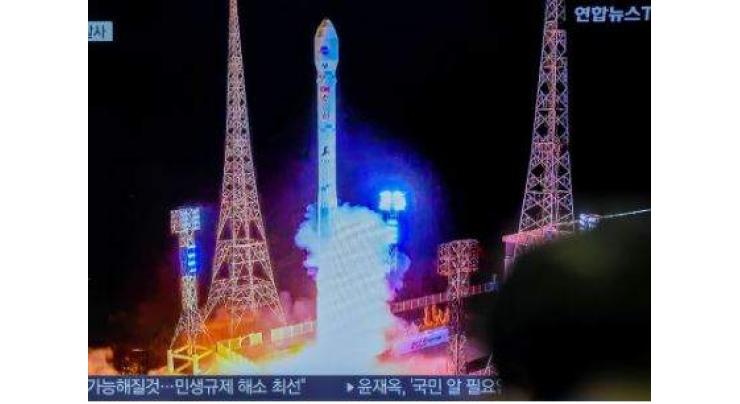
North Korea's Military Satellite Launch Fails As Rocket Explodes Mid-flight
Abdullah Hussain (@Abdulla99267510) Published May 27, 2024 | 09:04 PM

This launch occurred just hours after Pyongyang warned of an impending satellite launch by June 4, which would have been its second spy satellite in orbit.
SEOUL: (UrduPoint/UrduPoint / Pakistan Point News-May 27th, 2024) North Korea's attempt to launch a new military reconnaissance satellite ended in failure on Monday when a newly developed rocket engine exploded mid-flight.
This launch occurred just hours after Pyongyang warned of an impending satellite launch by June 4, which would have been its second spy satellite in orbit. However, the effort ended in failure, marking another setback following two similar failures last year. North Korea had successfully placed its first spy satellite in orbit in November.
"The launch of the new satellite carrier rocket failed when it exploded in mid-air during the flight of the first stage," the deputy director general of North Korea's National Aerospace Technology Administration reported through state media. An initial analysis indicated that the failure was likely due to a newly developed liquid fuel rocket motor, though other potential causes are being investigated.
The officials in South Korea and Japan confirmed the launch failure. South Korea's Joint Chiefs of Staff (JCS) reported that the projectile was launched from North Korea's west coast at around 10:44 p.m. local time (1344 GMT). Debris from the rocket was detected in the sea just two minutes after launch.
The object launched by North Korea disappeared over the Yellow Sea, according to Japanese Chief Cabinet Secretary Yoshimasa Hayashi, who stated that nothing appeared to have entered space. "These launches violate relevant security council resolutions and are a serious matter concerning the safety of our people," Hayashi said.
Japanese broadcaster NHK aired footage of what seemed to be an orange dot flying into the night sky and then bursting into flames near the China-North Korea border. A Japanese defense ministry official suggested that the color of the flames indicated burning liquid fuel, though further analysis is needed.
The launch was believed to have originated from Dongchang-ri, the location of North Korea's main space flight center. Japan issued an emergency warning for residents in the south to take cover, but later lifted the warning, stating the missile was not expected to fly over Japanese territory.
The failed launch was North Korea's attempt to place a second spy satellite into orbit. After multiple failed attempts, North Korea successfully placed its first such satellite in orbit in November. The first attempt with the new Chollima-1 satellite rocket in May of the previous year failed due to an unstable engine system and fuel issues. Another attempt in August also ended in failure when the rocket boosters malfunctioned, causing the payloads to crash into the sea.
Despite these failures, U.S. space experts confirmed in February that North Korea's first spy satellite, Malligyong-1, remained operational, showing changes in its orbit indicating Pyongyang's control over the spacecraft. North Korean state media claimed the satellite had transmitted photos of significant locations like the Pentagon and White House, though no images have been released publicly.
The successful November launch followed North Korean leader Kim Jong Un's visit to Russia's advanced space launch center, where President Vladimir Putin pledged assistance in developing satellites. The extent of this aid remains unspecified and may violate United Nations Security Council resolutions against North Korea.
The reports suggested that Russian experts have visited North Korea to assist with its satellite and space rocket programs. North Korea asserts the necessity of a military reconnaissance satellite to monitor U.S. and South Korean military activities.
Related Topics
Recent Stories

Cricket: England v West Indies 3rd Test scoreboard

Finance minister briefs Chinese officials on reform agenda, engagement with IMF

Finland says Russian vessel violated its territorial waters

Olympic opening ceremony under way on River Seine

West Indies' treble strike rocks England in third Test

Ukraine court orders detention of suspect in murder of nationalist ex-MP

Long queues, ticketing problems ahead of Paris opening ceremony

Rana Sanaullah Khan joins Paris 2024 Olympics inauguration reception

Glowing tributes mark 69th birthday of President Zardari at Governor's House

Players unaware of spying scandal as Canada Olympic coach sent home: official

Naqvi hails Pak women cricketers for going down fighting against SL

'Sabotage' on French rail network before Olympics: What we know
More Stories From World
-
Biden talks Gaza ceasefire efforts with king of Jordan
10 minutes ago -
Sinaloa Cartel co-founder pleads not guilty after stunning US capture
10 minutes ago -
Panama says Venezuela blocked ex-presidents going to observe polls
10 minutes ago -
Ethiopia mourns victims of landslide tragedy
30 minutes ago -
Khan Yunis fighting displaces 180,000 Gazans in four days: UN
30 minutes ago -
Trump slams rivals as he meets Netanyahu in Florida
40 minutes ago
-
Obama & his wife, Michelle, officially endorse US VP Kamala Harris for president
40 minutes ago -
Rain, cooling slow huge blaze in Canada's Jasper park
40 minutes ago -
Airbus and Boeing supremacy secure despite turbulence
40 minutes ago -
S.African police detain 95 Libyans at suspected military camp
1 hour ago -
'Slapping therapist' guilty over UK diabetic woman's death
2 hours ago -
Panama says Venezuela blocked flight of ex-presidents going to observe polls
2 hours ago